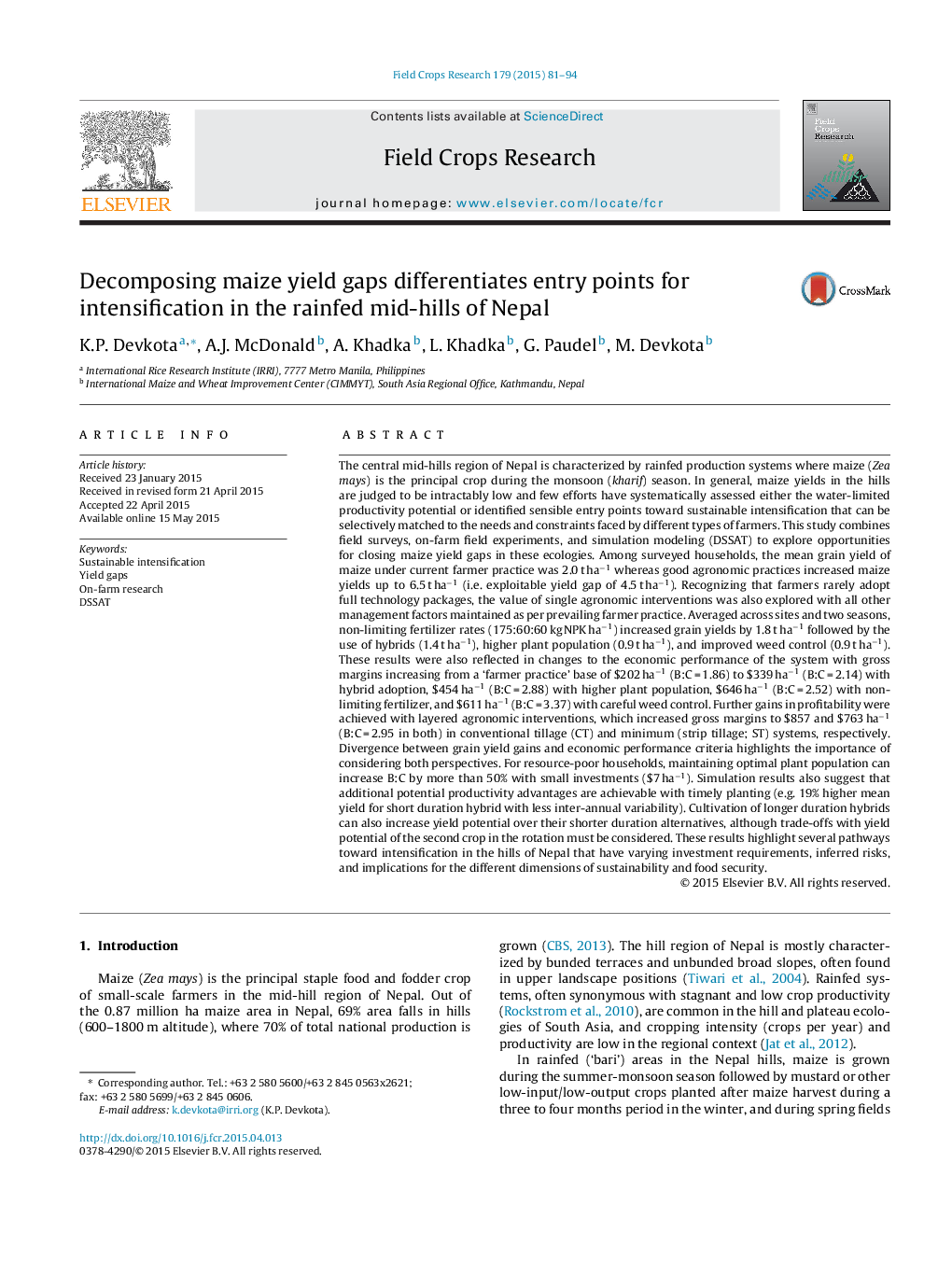| کد مقاله | کد نشریه | سال انتشار | مقاله انگلیسی | نسخه تمام متن |
|---|---|---|---|---|
| 6374869 | 1624684 | 2015 | 14 صفحه PDF | دانلود رایگان |
- In rainfed hill of Nepal, exploitable yield gap of maize is 4-4.5 t haâ1.
- Fertilizer, hybrid variety, optimum plant population and careful weed control are the four major entry points for the better yield of maize.
- Timely planting can increase maize yield up to 11-19%.
- Cultivation of longer duration hybrid can increase maize yield but trade-off with yield of second crop in rotation most be considered.
- By moving beyond technology 'packages' and targeting interventions to different farm types, the process of sustainable intensification may be accelerated.
The central mid-hills region of Nepal is characterized by rainfed production systems where maize (Zea mays) is the principal crop during the monsoon (kharif) season. In general, maize yields in the hills are judged to be intractably low and few efforts have systematically assessed either the water-limited productivity potential or identified sensible entry points toward sustainable intensification that can be selectively matched to the needs and constraints faced by different types of farmers. This study combines field surveys, on-farm field experiments, and simulation modeling (DSSAT) to explore opportunities for closing maize yield gaps in these ecologies. Among surveyed households, the mean grain yield of maize under current farmer practice was 2.0 t haâ1 whereas good agronomic practices increased maize yields up to 6.5 t haâ1 (i.e. exploitable yield gap of 4.5 t haâ1). Recognizing that farmers rarely adopt full technology packages, the value of single agronomic interventions was also explored with all other management factors maintained as per prevailing farmer practice. Averaged across sites and two seasons, non-limiting fertilizer rates (175:60:60 kg NPK haâ1) increased grain yields by 1.8 t haâ1 followed by the use of hybrids (1.4 t haâ1), higher plant population (0.9 t haâ1), and improved weed control (0.9 t haâ1). These results were also reflected in changes to the economic performance of the system with gross margins increasing from a 'farmer practice' base of $202 haâ1 (B:C = 1.86) to $339 haâ1 (B:C = 2.14) with hybrid adoption, $454 haâ1 (B:C = 2.88) with higher plant population, $646 haâ1 (B:C = 2.52) with non-limiting fertilizer, and $611 haâ1 (B:C = 3.37) with careful weed control. Further gains in profitability were achieved with layered agronomic interventions, which increased gross margins to $857 and $763 haâ1 (B:C = 2.95 in both) in conventional tillage (CT) and minimum (strip tillage; ST) systems, respectively. Divergence between grain yield gains and economic performance criteria highlights the importance of considering both perspectives. For resource-poor households, maintaining optimal plant population can increase B:C by more than 50% with small investments ($7 haâ1). Simulation results also suggest that additional potential productivity advantages are achievable with timely planting (e.g. 19% higher mean yield for short duration hybrid with less inter-annual variability). Cultivation of longer duration hybrids can also increase yield potential over their shorter duration alternatives, although trade-offs with yield potential of the second crop in the rotation must be considered. These results highlight several pathways toward intensification in the hills of Nepal that have varying investment requirements, inferred risks, and implications for the different dimensions of sustainability and food security.
Journal: Field Crops Research - Volume 179, 1 August 2015, Pages 81-94
